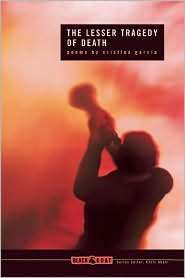Note: Cristina Garcia, who was nominated for the National Book Award for Dreaming in Cuban, has been the recipient of a Guggenheim Fellowship and a Whiting Writers’ Award.
“Knots of grief. Can grief be a gift?
I fear it will make me your enemy but you must
Trust me: I offer this in peace.”–Cristina Garcia, to her lost brother
In deciding  to explore the complex and agonizing story of her brother’s life, Cuban author Cristina Garcia abandons her usual prose and writes in poetry, a form more appropriate for the intense feelings she bears toward her brother, a sick and broken man who was routinely victimized by his family as a child. Tracing her brother’s life from his birth in 1960, when the family became one of the first families to escape to New York from Castro’s Cuba, she recreates his life through poetry, up to 2007, when this book was first published. The short poems in free verse require the reader to fill in some blanks, and as one does, the growing horrors of this child’s life; the author’s own feelings of guilt for being unable (for whatever reason) to stop the torments her brother endured; her intense resentments against her parents, especially her mother; and her abiding sadness for the shell of a man her brother has become threaten to overwhelm the reader in the same degree that they must have overwhelmed the author.
to explore the complex and agonizing story of her brother’s life, Cuban author Cristina Garcia abandons her usual prose and writes in poetry, a form more appropriate for the intense feelings she bears toward her brother, a sick and broken man who was routinely victimized by his family as a child. Tracing her brother’s life from his birth in 1960, when the family became one of the first families to escape to New York from Castro’s Cuba, she recreates his life through poetry, up to 2007, when this book was first published. The short poems in free verse require the reader to fill in some blanks, and as one does, the growing horrors of this child’s life; the author’s own feelings of guilt for being unable (for whatever reason) to stop the torments her brother endured; her intense resentments against her parents, especially her mother; and her abiding sadness for the shell of a man her brother has become threaten to overwhelm the reader in the same degree that they must have overwhelmed the author.

A variety of points of view enable the author to convey a full picture of her brother’s life. His best friend and the woman he almost married both share their memories–and his betrayals of them. Sometimes the author remains an objective narrator, and sometimes she addresses her brother directly. In the five “Deseo” poems, for example, she tells him, and the reader, what she wishes for him: “to recover the lost wealth/of boyhood,” “to unloose the lost grace between us,” and “to turn back the clock, shield us from terror.” She asks him to “give up your religion” and “un-nail yourself/from your cross.” To each of these, her brother provides imagined “Repuestas” –answers—telling her that “Our childhood is dead./Nothing is left but this:/ your words against mine.” He reminds her that “A word from you/might have stopped [the abuse]./ You were good/with words.” And he now believes “It’s too late for me and you./ Nothing’s true except what the body tells.” In a final blow, she imagines him telling her to “Save your unburdenings, sister./ I’ve got enough problems/as it is/ Uneasy? Try tranquilizers.”
The chronological orderi ng of the poems allows the author to create a loose narrative that explains the hostility and dysfunction in the Garcia family and shows how a gentle, sweet, and trusting boy became an addled wreck of a man. On the day he was born, according to his aunt, his mother asked “Quien es?”—“Who are you?”—when her son was put into her arms. She blamed him for the fact that he was her third child in thirty-five months, that her teeth fell out, that she became fat, and that no one thought she was pretty anymore. As a child anxious to please, the boy gave away toys and candy to friends, learned to dance from his sisters, nearly killed himself trying to learn how to ride a bike, but failed to star when he had a chance to score the winning run in Little League baseball. After that, he “kept on losing.”
ng of the poems allows the author to create a loose narrative that explains the hostility and dysfunction in the Garcia family and shows how a gentle, sweet, and trusting boy became an addled wreck of a man. On the day he was born, according to his aunt, his mother asked “Quien es?”—“Who are you?”—when her son was put into her arms. She blamed him for the fact that he was her third child in thirty-five months, that her teeth fell out, that she became fat, and that no one thought she was pretty anymore. As a child anxious to please, the boy gave away toys and candy to friends, learned to dance from his sisters, nearly killed himself trying to learn how to ride a bike, but failed to star when he had a chance to score the winning run in Little League baseball. After that, he “kept on losing.”
His father beat him. His mother ran away to South America, and upon her return pretended she did not recognize him. He had his first joint at the age of twelve, and when he was kicked out of the house almost immediately after that, he never returned, remaining on his own in Red Hook, part of Brooklyn. Eventually diagnosed with bipolar disorder, the boy became a man who tried much and failed at everything. His miserable life eventually inspires the author to ask, “So what are we waiting for, hermano?/The lesser tragedy of death?”
 In her powerful, often overwhelming, examination of a life utterly destroyed, Garcia unflinchingly examines the role of their cold, unfeeling parents; the streets into which her brother was thrust and in which he had to try to make a life even before he became a teenager; of her brother’s own responsibility for many of his problems; and, ultimately the responsibility she and her sister may bear for failing him in moments of his youth when their actions might have made a difference. Her poems are all the more intense because the author compresses so much into so few words and because she is so clearly agonizing over her brother’s fate and her own level of responsibility, if any, for it. THE LESSER TRAGEDY OF DEATH is a heartfelt exploration of a dysfunctional family who did not have the ability or the will to act any differently, a collection of poems which attempts to give meaning to a life that might otherwise have been lost completely.
In her powerful, often overwhelming, examination of a life utterly destroyed, Garcia unflinchingly examines the role of their cold, unfeeling parents; the streets into which her brother was thrust and in which he had to try to make a life even before he became a teenager; of her brother’s own responsibility for many of his problems; and, ultimately the responsibility she and her sister may bear for failing him in moments of his youth when their actions might have made a difference. Her poems are all the more intense because the author compresses so much into so few words and because she is so clearly agonizing over her brother’s fate and her own level of responsibility, if any, for it. THE LESSER TRAGEDY OF DEATH is a heartfelt exploration of a dysfunctional family who did not have the ability or the will to act any differently, a collection of poems which attempts to give meaning to a life that might otherwise have been lost completely.
ALSO by Cristina Garcia: HERE IN BERLIN
Notes: The author’s photo by Norma Quintana appears here: www.examiner.com. Her website is here: http://www.cristinagarcianovelist.com/
Red Hook is in South Brooklyn and is where her brother lived. The sign photo is from www.apartmenttherapy.com.
Enjoying fine summer weather, residents of Red Hook gather on a pier at an abandoned industrial site along a section of the East River. See wirednewyork.com
